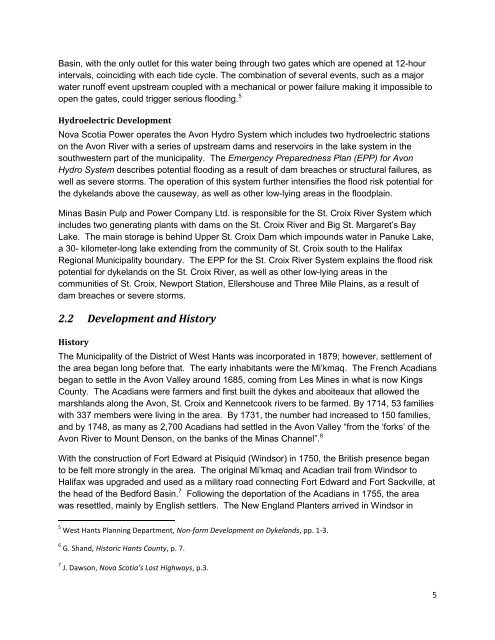Municipality Climate Adaptation Case Study Report
Municipality Climate Adaptation Case Study Report
Municipality Climate Adaptation Case Study Report
Create successful ePaper yourself
Turn your PDF publications into a flip-book with our unique Google optimized e-Paper software.
Basin, with the only outlet for this water being through two gates which are opened at 12-hour<br />
intervals, coinciding with each tide cycle. The combination of several events, such as a major<br />
water runoff event upstream coupled with a mechanical or power failure making it impossible to<br />
open the gates, could trigger serious flooding. 5<br />
Hydroelectric Development<br />
Nova Scotia Power operates the Avon Hydro System which includes two hydroelectric stations<br />
on the Avon River with a series of upstream dams and reservoirs in the lake system in the<br />
southwestern part of the municipality. The Emergency Preparedness Plan (EPP) for Avon<br />
Hydro System describes potential flooding as a result of dam breaches or structural failures, as<br />
well as severe storms. The operation of this system further intensifies the flood risk potential for<br />
the dykelands above the causeway, as well as other low-lying areas in the floodplain.<br />
Minas Basin Pulp and Power Company Ltd. is responsible for the St. Croix River System which<br />
includes two generating plants with dams on the St. Croix River and Big St. Margaret’s Bay<br />
Lake. The main storage is behind Upper St. Croix Dam which impounds water in Panuke Lake,<br />
a 30- kilometer-long lake extending from the community of St. Croix south to the Halifax<br />
Regional <strong>Municipality</strong> boundary. The EPP for the St. Croix River System explains the flood risk<br />
potential for dykelands on the St. Croix River, as well as other low-lying areas in the<br />
communities of St. Croix, Newport Station, Ellershouse and Three Mile Plains, as a result of<br />
dam breaches or severe storms.<br />
2.2 Development and History<br />
History<br />
The <strong>Municipality</strong> of the District of West Hants was incorporated in 1879; however, settlement of<br />
the area began long before that. The early inhabitants were the Mi’kmaq. The French Acadians<br />
began to settle in the Avon Valley around 1685, coming from Les Mines in what is now Kings<br />
County. The Acadians were farmers and first built the dykes and aboiteaux that allowed the<br />
marshlands along the Avon, St. Croix and Kennetcook rivers to be farmed. By 1714, 53 families<br />
with 337 members were living in the area. By 1731, the number had increased to 150 families,<br />
and by 1748, as many as 2,700 Acadians had settled in the Avon Valley “from the ‘forks’ of the<br />
Avon River to Mount Denson, on the banks of the Minas Channel”. 6<br />
With the construction of Fort Edward at Pisiquid (Windsor) in 1750, the British presence began<br />
to be felt more strongly in the area. The original Mi’kmaq and Acadian trail from Windsor to<br />
Halifax was upgraded and used as a military road connecting Fort Edward and Fort Sackville, at<br />
the head of the Bedford Basin. 7 Following the deportation of the Acadians in 1755, the area<br />
was resettled, mainly by English settlers. The New England Planters arrived in Windsor in<br />
5 West Hants Planning Department, Non-farm Development on Dykelands, pp. 1-3.<br />
6 G. Shand, Historic Hants County, p. 7.<br />
7 J. Dawson, Nova Scotia’s Lost Highways, p.3.<br />
5














